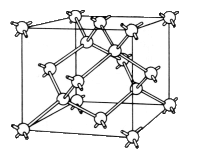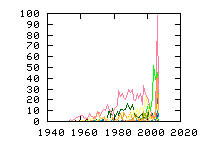« Previous
1
Next »
(22 hits, 1/1)
Showing
10, 25, 50, 100, 500, 1000, all papers per page.
Sort by:
last publication date,
older publication date,
last update date.
- 1. J. Appl. Phys. 104, 014106 (2008) , “Analysis of electrically biased paramagnetic defect centers in HfO2 and HfxSi1−xO2 / (100)Si interfaces”, P. T. Chen, B. B. Triplett, J. J. Chambers, L. Colombo, P. C. McIntyre, and Y. NishiThis study reports on the first experimental observations of electrically biased paramagnetic defects at 800 °C N2 annealed HfxSi1−xO2 (x=0.4, and 0.6)/(100)Si and HfO2/(100)Si interfaces in metal oxide silicon... (Read more)
- 2. Phys. Rev. B 75, 085439 (2007) , “Real-space investigation of fast diffusion of hydrogen on Si(001) by a combination of nanosecond laser heating and STM”, C. H. Schwalb, M. Lawrenz, M. Dürr,, and U. HöferThe rearrangement of silicon dangling bonds induced by pulsed laser heating of monohydride-covered Si(001) surfaces has been studied by means of scanning tunneling microscopy (STM). The initial configurations, which were created by laser-induced thermal desorption, consist of isolated pairs of... (Read more)
- 3. Phys. Rev. B 75, 085423 (2007) , “Room-temperature atmospheric oxidation of Si nanocrystals after HF etching”, X. D. Pi, L. Mangolini, S. A. Campbell, and U. KortshagenThe effect of HF etching of the silicon oxide shell covering the surface of Si nanocrystals (NCs) on the subsequent room-temperature atmospheric oxidation of Si-NCs has been investigated by means of photoluminescence measurements, Fourier transform infrared spectroscopy, and electron paramagnetic... (Read more)
- 4. Phys. Rev. B 75, 075201 (2007) , “Influence of isotopic substitution and He coimplantation on defect complexes and voids induced by H ions in silicon”, O. Moutanabbir, B. Terreault, M. Chicoine, F. Schiettekatte, and P. J. SimpsonWe present a detailed study of the comparative thermal evolutions of H- and D-related defects in silicon implanted with 2×1016 H or D/cm2, or coimplanted with 0.25×1016 He/cm2 and 0.7×1016 H/cm2, in both orders.... (Read more)
- 5. J. Appl. Phys. 99, 113520 (2006) , “Effects of hydrogen bond redistribution on photoluminescence of a-SiC:H films under thermal treatment”, A. V. Vasin, S. P. Kolesnik, A. A. Konchits, V. I. Kushnirenko, V. S. Lysenko, A. N. Nazarov, A. V. Rusavsky, and S. AshokHydrogenated amorphous silicon carbide (a-SiC:H) films have been deposited using magnetron sputtering technique. An integrated investigation of the effect of vacuum annealing temperature on photoluminescence properties and paramagnetic defects and its correlation with structural... (Read more)
- 6. Phys. Rev. B 74, 205324 (2006) , “Surface smoothness of plasma-deposited amorphous silicon thin films: Surface diffusion of radical precursors and mechanism of Si incorporation”, Mayur S. Valipa, Tamas Bakos, and Dimitrios MaroudasWe present a detailed analysis of the fundamental atomic-scale processes that determine the surface smoothness of hydrogenated amorphous silicon (a-Si:H) thin films. The analysis is based on a synergistic combination of molecular-dynamics (MD) simulations of radical precursor migration on surfaces... (Read more)
- 7. Microelectron. Reliability 45, 71 (2005) , “A comprehensive model of PMOS NBTI degradation ”,Negative bias temperature instability has become an important reliability concern for ultra-scaled Silicon IC technology with significant implications for both analog and digital circuit design. In this paper, we construct a comprehensive model for NBTI phenomena within the framework of the standard reaction–diffusion model. We demonstrate how to solve the reaction–diffusion equations in a way that emphasizes the physical aspects of the degradation process and allows easy generalization of the existing work. We also augment this basic reaction–diffusion model by including the temperature and field-dependence of the NBTI phenomena so that reliability projections can be made under arbitrary circuit operating conditions. (Read more)
- 8. Microelectron. Reliability 45, 57 (2005) , “Characterization of interface defects related to negative-bias temperature instability SiON/Si<100> systems ”,Interface defects related to negative-bias temperature instability (NBTI) in an ultrathin plasma-nitrided SiON/ Si<100> system were characterized by using conductance–frequency measurements, electron-spin resonance measure- ments, and synchrotron radiation X-ray photoelectron spectroscopy. It was confirmed that NBTI is reduced by using D2-annealing instead of the usual H2-annealing. Interfacial Si dangling bonds (Pb1 and Pb0 centers) were detected in a sample subjected to negative-bias temperature stress (NBTS). Although we suggest that NBTS also generates non-Pb defects, it does not seem to generate nitrogen dangling bonds. These results show that NBTI of the plasma-nitrided SiON/Si system is predominantly due to Pb depassivation. Plasma nitridation was also found to increase the Pb1/Pb0 density ratio, modify the Pb1 defect structure, and increase the latent interface trap density by generating Si suboxides at the interface. These changes are likely to be the causes of NBTI in ultrathin plasma-nitrided SiON/Si systems. (Read more)
- 9. Phys. Rev. Lett. 92, 087601 (2004) , “Hydrogen-Release Mechanisms in the Breakdown of Thin SiO2 Films”, J. Suñé and E. Y. WuThe mechanism of hydrogen release from the anode Si/SiO2 interface that triggers defect generation and finally the dielectric breakdown of the oxide in metal-oxide-semiconductor structures is investigated. Extensive experimental charge-to-breakdown statistics are used to derive the defect... (Read more)
- 10. Appl. Phys. Lett. 82, 3677-3679 (2003) , “Interface defects responsible for negative-bias temperature instability in plasma-nitrided SiON/Si(100) systems”, Shinji Fujieda, Yoshinao Miura, and Motofumi SaitohInterface defects generated by negative-bias temperature stress (NBTS) in an ultrathin plasma- nitrided SiON/Si(100) system were characterized by using D2 annealing, conductance-frequency measurements, and electron-spin resonance measurements. D2 annealing was shown to lower... (Read more)
- 11. J. Appl. Phys. 94, 1 (2003) , “Negative bias temperature instability: Road to cross in deep submicron silicon semiconductor manufacturing”,We present an overview of negative bias temperature instability (NBTI) commonly observed in p-channel metal–oxide–semiconductor field-effect transistors when stressed with negative gate voltages at elevated temperatures. We discuss the results of such stress on device and circuit... (Read more)
- 12. Appl. Phys. Lett. 81, 2397-2399 (2002) , “Hydrogen redistribution induced by negative-bias-temperature stress in metal–oxide–silicon diodes”, Ziyuan LiuPoly-Si/SiO2/Si diodes in which oxides were grown thermally under wet oxidation conditions and subsequently treated by a post-oxidation anneal (POA) have been characterized electrically and chemically before and after applying negative-bias-temperature stress (NBTS). It was confirmed that... (Read more)
- 13. Appl. Phys. Lett. 81, 1839 (2002) , “Dual behavior of H+ at Si–SiO2 interfaces: Mobility versus trapping”, S. N. Rashkeev, D. M. Fleetwood, R. D. Schrimpf, S. T. PantelidesWe report first-principles calculations showing that protons in the vicinity of a Si–SiO2 interface can behave in two different ways. At an abrupt interface without suboxide bonds (Si–Si bonds at the oxide side of the interface) H+ does not become trapped but migrates... (Read more)
- 14. Appl. Phys. Lett. 81, 1818 (2002) , “Interface structures generated by negative-bias temperature instability in Si/SiO2 and Si/SiOxNy interfaces”, J. Ushio, T. Maruizumi, K. Kushida-AbdelghafarWe used a density functional method to investigate the mechanism of negative-bias temperature instability (NBTI) and resultant structural changes of Si/SiO2 and Si/SiOxNy interfaces. The reaction energies for the water- and hydrogen-originated... (Read more)
- 15. Phys. Rev. Lett. 87, 165506 (2001) , “Defect Generation by Hydrogen at the Si-SiO2 Interfaces”, S. N. Rashkeev, D. M. Fleetwood, R. D. Schrimpf, and S. T. PantelidesHydrogen is known to passivate Si dangling bonds at the Si-SiO 2 interface, but the subsequent arrival of H + at the interface causes depassivation of Si-H bonds. Here we report first-principles density functional calculations, showing that, contrary to conventional... (Read more)
- 16. Phys. Rev. Lett. 83, 372 (1999) , “Hydrogen Electrochemistry and Stress-Induced Leakage Current in Silica”, Peter E. Bl?chl and James H. StathisHydrogen-related defects in oxygen-deficient silica, representing the material of a thermal gate oxide, are analyzed using first-principles calculations. Energetics and charge-state levels of oxygen vacancies, hydrogen, and their complexes in the silica framework are mapped out. The neutral hydrogen... (Read more)
- 17. Phys. Rev. B 58, 3842 (1998) , “Electron Paramagnetic Resonance Study of Hydrogen-Vacancy Defects in Crystalline Silicon”, P. Stallinga, P. Johannesen, S. Herstm, K. Bonde Nielsen, B. Bech Nielsen, J. R. Byberg.Electron paramagnetic resonance measurements on float-zone silicon implanted with protons at ?50 K followed by heating to room temperature have revealed two signals S1a and S1b belonging to the S1 group of signals. S1a and S1b both originate from defects... (Read more)
- 18. Phys. Rev. Lett. 79, 1507 (1997) , “Identification of the Silicon Vacancy Containing a Single Hydrogen Atom by EPR”, B. Bech Nielsen, P. Johannesen, P. Stallinga, K. Bonde Nielsen
- 19. Phys. Rev. B 47, 3620-3625 (1993) , “{H,B}, {H,C}, and {H,Si} pairs in silicon and germanium”, Dj. M. Maric, P. F. Meier, S. K. EstreicherThe interactions between interstitial H and substitutional B, C, and Si in crystalline silicon and germanium are studied in molecular clusters at the ab initio Hartree-Fock level with large basis sets. The energetics, electronic structures, and relative stabilities of these pairs are determined. Our... (Read more)
- 20. Phys. Rev. B 39, 10791-10808 (1989) , “Theory of hydrogen diffusion and reactions in crystalline silicon”, Chris G. Van de Walle, P. J. H. Denteneer, Y. Bar-Yam, and S. T. PantelidesThe behavior of hydrogen in crystalline silicon is examined with state-of-the-art theoretical techniques, based on the pseudopotential-density-functional method in a supercell geometry. Stable sites, migration paths, and barriers for different charge states are explored and displayed in total-energy... (Read more)
- 21. Phys. Rev. B 31, 5525-5528 (1985) , “Mechanism for hydrogen compensation of shallow-acceptor impurities in single-crystal silicon”, N. M. JohnsonExperimental results are presented which identify the following chemical reaction as being responsible for compensation of shallow-acceptor impurities when single-crystal silicon is exposed to monatomic hydrogen: A-+h++H0↔(AH)0, where A-... (Read more)
- 22. Phys. Lett. A 99, 117 (1983) , “Low-Symmetry EPR Center in Hydrogen-Implanted Silicon”, Yu.V. Gorelkinskii, N.N. NevinnyiA new S = 1/2 EPR spectrum, labeled Si-AA2, arises from a negative-charge-state defect which has a low symmetry(C1). It is produced in crystalline silicon by hydrogen implantation at ≈20°C followed by annealing at ≈580°C and disappears completely at 700°C. The kinetics... (Read more)Si| EPR ion-implantation| 29Si AA2 C1 Hydrogen Si-H Vsi cluster(>3) p-type triclinic vacancy .inp files: Si/AA2/AA2.inp | last update: Takahide Umeda
« Previous
1
Next »
(22 hits, 1/1)
Showing
10, 25, 50, 100, 500, 1000, all papers per page.
Sort by:
last publication date,
older publication date,
last update date.
All papers (3399)
Updated at 2010-07-20 16:50:39
Updated at 2010-07-20 16:50:39
(view as: tree
,
cloud
)
| 1329 | untagged |
Materials
(111 tags)
Others(101 tags)
Technique
(46 tags)
Details
(591 tags)
Bond(35 tags)
Defect(interstitial)(18 tags)
Defect(vacancy)(15 tags)
Defect-type(19 tags)
Element(65 tags)
Energy(8 tags)
Isotope(56 tags)
Label(303 tags)
Sample(17 tags)
Spin(8 tags)
Symmetry(15 tags)

